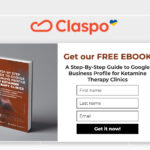What Is Product-Led Growth?
Product-led growth (PLG) is a business methodology where product usage drives customer acquisition, retention, and expansion. Unlike traditional sales-led or marketing-led approaches, PLG puts the product experience at the center of every business function. In this way, it’s more than just a buzzword; it’s a fundamental shift in how companies, especially in the SaaS realm, approach their relationship with customers. This strategy isn’t merely about acquiring and retaining customers; it’s about creating experiences that genuinely delight them.
And yes, I choose the word “delight” with careful intention.
Raising the Bar: Why Satisfaction Is Just the Starting Line
Having spent over two decades in software product development and project management, I’ve observed a subtle yet crucial distinction in our industry’s vocabulary. In our daily standups and sprint reviews, we often speak in terms of “satisfying requirements” or “meeting acceptance criteria.” We move tickets from “In Progress” to “Done” on our Kanban project management dashboards, marking features as “completed” or “requirements met.”
This language, while precise and necessary for project management, reveals a potentially limiting mindset.
Think about it: When was the last time you told a friend about a product that merely “met your requirements”? We don’t share stories about products that simply work as expected. We rave about experiences that surprise us, that make us smile, that solve problems we didn’t even realize we had. That’s the difference between satisfaction and delight.
Meeting requirements is like following a recipe to the letter—you’ll probably end up with an edible meal. But delighting customers? That’s like a chef who not only masters the basics but adds an unexpected flourish that transforms a good meal into an unforgettable dining experience.
In the software world, satisfaction might mean your application performs its core functions without bugs. Delight happens when users discover thoughtful features that make their lives easier in ways they hadn’t anticipated.
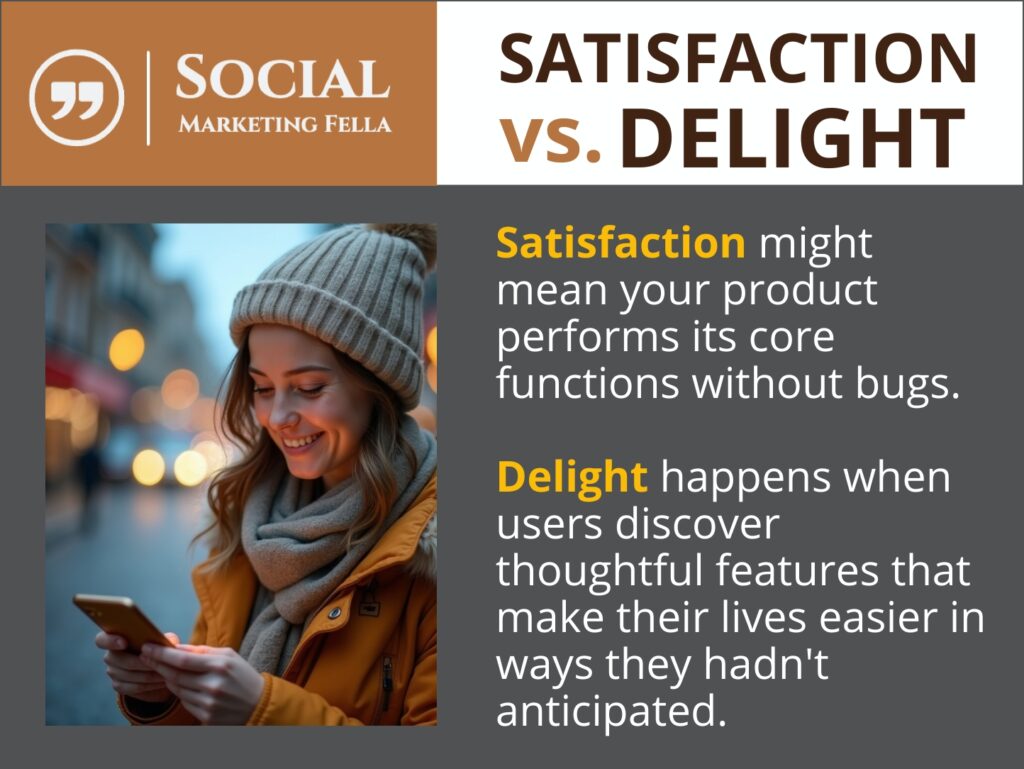
When examining the fundamental distinctions between various business approaches, we can distill the key differences into a clear and simplified structure.
Meeting Requirements
- Satisfies basic customer needs and expectations
- Focuses on delivering promised functionality
- Ensures basic customer satisfaction
- Represents the minimum acceptable standard
- Addresses fundamental customer problems
Delighting Customers
- Goes beyond basic expectations
- Creates memorable positive experiences
- Generates emotional connections
- Delivers unexpected value
- Inspires customer loyalty and advocacy
This distinction becomes particularly crucial in the context of Product-Led Growth. While traditional sales-led approaches might focus on checking boxes and meeting specifications, PLG demands a deeper understanding of user psychology and emotion. It requires us to move beyond the binary state of “working/not working” to create experiences that forge emotional connections with users.
The business impact of this distinction is profound. When we merely satisfy requirements, we create transactional relationships—customers stay until a better option comes along. But when we delight users, we create advocates who not only stick around but also enthusiastically spread the word about our product. These emotional bonds translate into tangible business outcomes:
- Higher retention rates
- Increased lifetime value
- Organic growth through word-of-mouth marketing
Consider companies like Slack or Notion. They didn’t succeed merely by satisfying communication or documentation requirements—plenty of tools already did that. They won by delighting users with intuitive interfaces, clever features, and moments of joy in daily use. Their success demonstrates how emotional engagement, not just functional adequacy, drives sustainable growth in the modern software landscape.
This shift from satisfaction to delight represents a broader evolution in product development philosophy. It’s about recognizing that while meeting requirements is necessary, it’s no longer sufficient in a world where users have increasingly sophisticated expectations. The companies that will thrive in this new era are those that understand the difference between checking boxes and creating experiences that resonate on an emotional level.
In essence, while satisfaction ensures your product works, delight ensures it matters to your users. And in the realm of Product-Led Growth, that difference isn’t just semantic—it’s strategic.
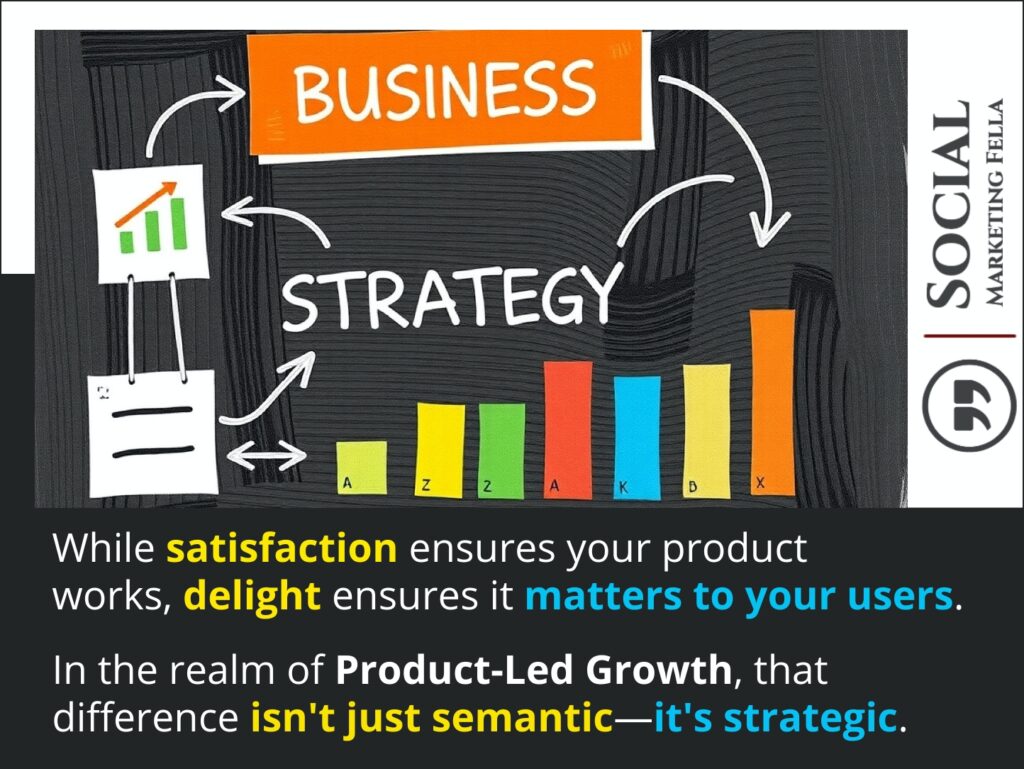
Strategic Pillars of Product-Led Growth Success
Successful implementation of requires careful attention to several key criteria. According to Hotjar’s analysis, there are four fundamental elements that companies must master to achieve success with PLG.
Market
First, the market consideration is crucial. Your product must address a broad, substantial market rather than focusing on a narrow niche. This requirement ensures there’s enough potential for significant scale and growth. A large market provides more opportunities for expansion and allows for natural product evolution while maintaining a strong customer base. Companies targeting niche markets may find it challenging to achieve the momentum necessary for successful PLG implementation.
Business Model
The second criterion focuses on the business model. The key here is accessibility and transparency in both pricing and usage. Companies must implement self-service customer acquisition systems where users can easily sign up and make payments through common methods like credit cards or PayPal. The pricing structure should be clear and affordable, avoiding complex enterprise-level pricing schemes. Additionally, offering a freemium model or free trial period is essential as it reduces barriers to entry and allows potential customers to experience the product’s value firsthand.
Channel Strategy
The third element revolves around channel strategy. Successful PLG companies prioritize cost-effective marketing channels that provide sustainable customer acquisition. This typically includes leveraging word-of-mouth marketing, developing robust content marketing strategies, and implementing targeted PPC advertising campaigns that offer positive ROI. These approaches allow companies to maintain reasonable customer acquisition costs while scaling their user base effectively.
Product Value Proposition
Finally, the product itself must meet specific criteria. It should offer a broad value proposition that appeals to a wide range of users while maintaining low complexity. The time-to-value – the period between when a user first encounters the product and when they experience its benefits – must be minimal. This rapid demonstration of value is crucial for converting free users to paying customers and maintaining engagement throughout the user journey. The product should be intuitive enough that users can understand and begin using it with minimal assistance or training.
These four pillars of successful PLG implementation provide a framework for companies considering or currently executing a product-led growth strategy. Each element plays a vital role in creating a sustainable and scalable growth model that leverages the product itself as the primary driver of customer acquisition and retention.
Successful Product-Led Growth Examples: Companies That Got It Right
1. Calendly
Calendly’s rise to become the default scheduling tool is a masterclass in product-led growth. The company identified a universal pain point – the tedious back-and-forth email chains to schedule meetings – and solved it with an elegantly simple solution. By starting with a free tier that allowed users to experience the core value proposition immediately (one-click scheduling), Calendly made its product viral by design: every time a user sent their Calendly link to schedule a meeting, they were essentially creating a product demo for the recipient.
This natural virality meant that recipients, after experiencing how seamless the scheduling process was, often became users themselves. The platform further accelerated adoption by integrating seamlessly with popular calendar applications and email clients, making it a natural extension of existing workflows.
From a metrics perspective, this strategy proved incredibly successful – growing from a bootstrapped startup to reaching 10M+ users, securing a $3B+ valuation, and becoming used by 96% of Fortune 500 companies. The genius of Calendly’s PLG approach was in making the product itself the primary growth engine, where each use case automatically marketed the product to new potential users who collectively reduced their scheduling time by 90%.
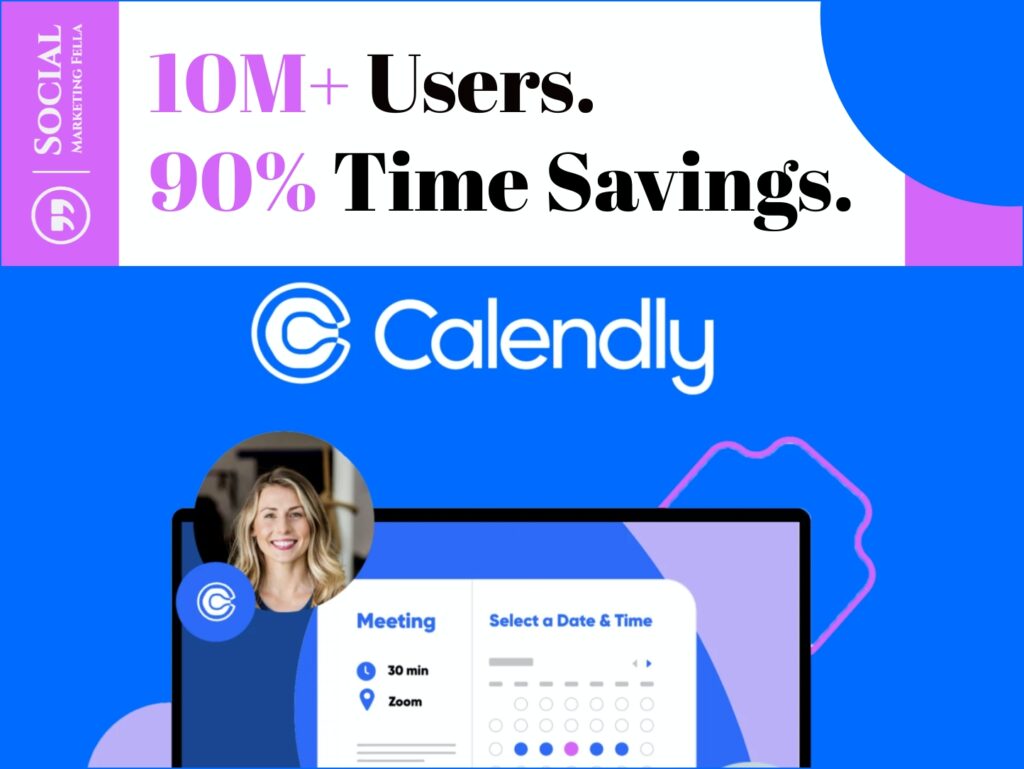
2. Zoom
The product-led growth success of Zoom is part product, part timing. The product itself was good with its simple, one-click meeting joins, free 40-minute meetings, and cross-platform compatibility, but the pandemic shot its stock prices off the charts. During the height of the COVID-19 pandemic, its stock value soared by almost 900% in a single year. The heyday wouldn’t last forever, and most recently, the company stock was down around -85% from its pandemic peak, but shows potential for gains as a mature company ahead of its Q4 earnings release with improved net margins, strong cash balance, and undervaluation.
User adoption and product-led growth during the pandemic had already turned the application into the leader in video conferencing, registering over 300 million daily meeting participants. Perhaps the most telling sign of Zoom’s cultural impact was its transformation into a verb – “Let’s Zoom” became part of everyday language, much like “Google it” did for search. This linguistic adoption reflected how deeply the platform had embedded itself into daily life. Through its product-led approach, Zoom didn’t just survive the pandemic – it emerged as the definitive solution for virtual communication, setting new standards for what users expect from video conferencing technology.
3. Slack
Confession: I hated Slack when it was first introduced.
The early version had different conversations going on at the same time without the intuitive structure the product has today. I was frustrated by the learning curve and asked of my colleagues, “Can’t we still just use Yahoo Messenger?” But others loved it, and by default, I had to use it.
Slack’s genius was in creating a network effect so powerful that individual preferences like mine became secondary to team necessity. As colleagues embraced the platform, holdouts like me found ourselves with a simple choice: adapt or be left out of critical conversations. This dynamic demonstrates a key principle of product-led growth: when a product becomes integral to how teams work, individual adoption becomes unavoidable.
Slack effectively turned potential friction points into opportunities for learning and engagement, eventually refining its interface to become the intuitive communication hub we know today. The product’s integration capabilities with other business tools made it increasingly indispensable, turning it from a simple chat tool into a central nervous system for workplace communication. The numbers tell the story: growing to a $7B+ valuation before acquisition by Salesforce for $27.7 billion, amassing 12M+ daily active users, and securing 156,000+ paying customers, including 88% of Fortune 100 companies.
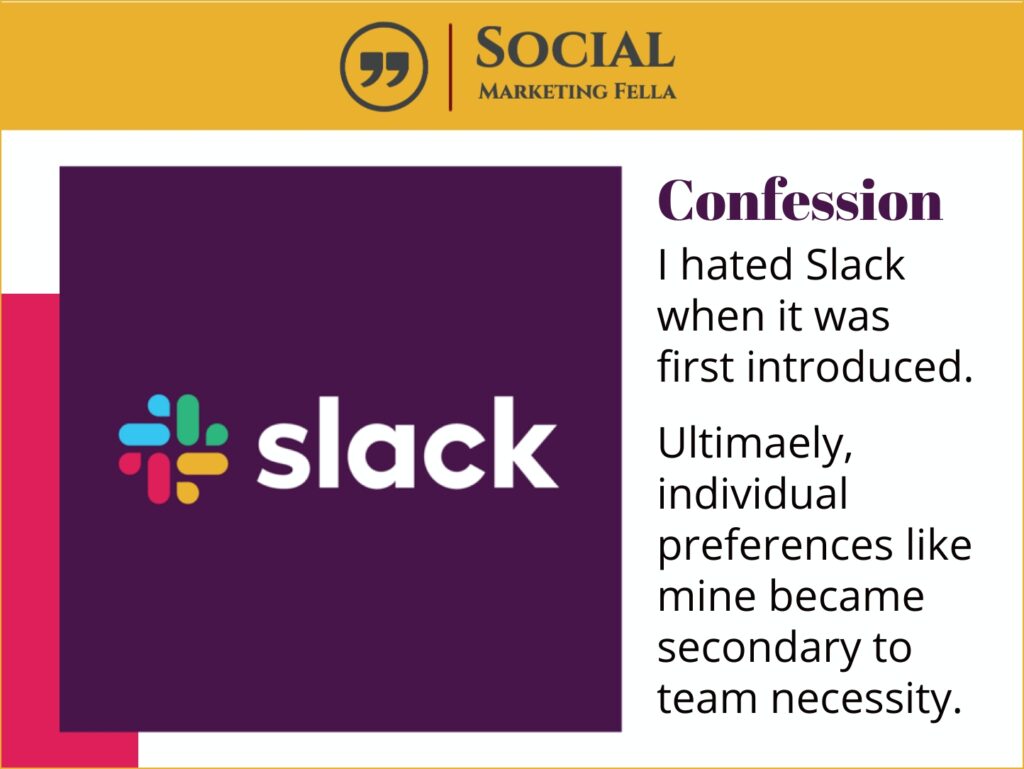
4. DocuSign
In the mid-2010’s I began consulting for an electronic signature company out of Eastern Europe. I still remember us having a team meeting in San Francisco’s China Town asking ourselves, “How do we become as popular as DocuSign?” The answer was: we wouldn’t. Although we gained some traction with organic search and content marketing initiatives I championed, there was no “cathching up” with DocuSign, despite having an arguably more robust and generous freemium product.
DocuSign’s dominance in the digital signature space exemplifies how product-led growth can transform an entire business process. By focusing on a single, crucial pain point – the need to sign documents remotely – DocuSign created a solution that was both simple to use and immediately valuable to users. The platform’s freemium model allowed individuals and small teams to experience the core functionality without any initial investment, while naturally scaling as usage increased.
What made DocuSign particularly effective was its ability to create a network effect through its product. Every time someone sent a document for signature, they were essentially introducing new users to the platform. This viral component, combined with the increasing need for remote document signing, helped DocuSign become the default choice for digital signatures. The platform’s ease of use and reliability meant that once users experienced it, they were likely to choose it for their own signature needs.
The company’s success in product-led growth is evident in its widespread adoption across industries. From real estate transactions to human resources documentation, DocuSign has become synonymous with digital signatures, much like Google for search or Zoom for video conferencing. This ubiquity has led to strong customer retention and natural expansion within organizations, as teams that start with basic signing needs often grow into enterprise-wide solutions.
5. Canva
Perhaps one of the most storied product-led growth applications came from the Land Down Under. Australian-based Canva stands as a shining example of how product-led growth can democratize a previously complex industry – graphic design. Through its intuitive design interface, Canva transformed what was once the exclusive domain of professional designers into an accessible tool for everyone, from small business owners to educators. The platform’s freemium model allows users to experience the core value proposition immediately, with thousands of templates, photos, and design elements available at no cost.
Suddenly, people’s diagrams, illustrations, and shared social images began to suck less.
What sets Canva apart is its vast template library and team collaboration features, which cater to both individual creators and enterprise teams. The platform’s success in making design accessible is evident in its user metrics: over 100 million monthly active users across 190+ countries, and an impressive adoption rate among Fortune 500 companies, with 85% of them utilizing the platform. This widespread adoption has led to a remarkable $40B valuation, validating its product-led approach.
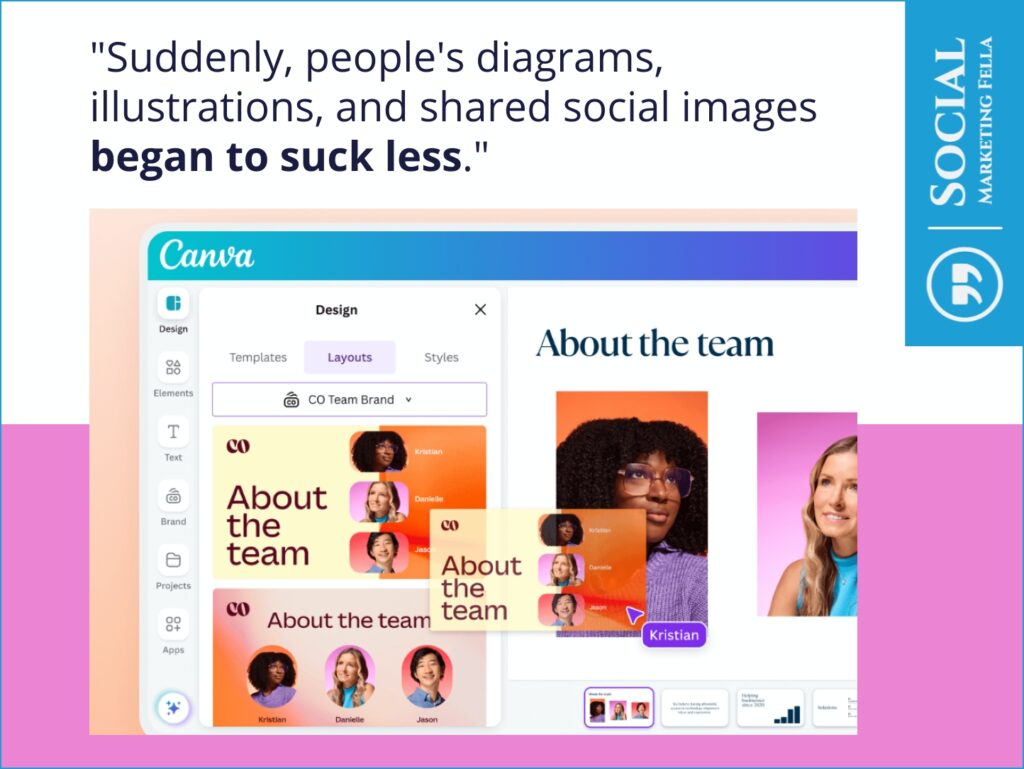
Lessons Learned
These examples of product-led growth share a common thread: they delivered exceptional value that competitors couldn’t match or were too slow to replicate. Success wasn’t just about checking feature boxes – it was about creating genuine customer delight. This focus on delighting users, rather than simply meeting basic requirements, remains the gold standard for achieving sustainable product-led growth in competitive markets.


